Table of contents
Light pipes might seem straightforward, but they fulfill a critical role in electronic equipment design; their use can simplify PCB layout, ease the job of the human factors engineer, and allow for a more compact design.
This article will discuss the function of light pipes, the technology behind them, the underlying physics, and the choices and options available to the equipment designer.
What is a light pipe?
A light pipe is a solid transparent plastic rod or an optical fiber used for transmitting light from a board-mounted LED to another location where it can conveniently be viewed, such as an indicator panel of an electronic module.
They offer several benefits, including clean status indication and simpler human factors engineering. The non-conductive light path requires no solder or crimped terminations and eliminates the potential of electrical shorts due to pinched wires; no solder or crimp terminations are needed.
Light pipes are critical components in many modern electronics applications. Adding a light pipe is a cost-effective solution to help eliminate many of the steps otherwise required to transport light from one place to another.
How are they used?
Light pipes have applications in various industries.
Healthcare
In healthcare, LED Indication and Illumination solutions enable crucial Human Machine Interface (HMI) designs in a range of medical technology applications.
Medical applications for light pipes include:
- Connected life technologies
- Medical disposable devices
- Medical smart devices
- Medical human machine interface
Industrial automation & control
Light pipes help ensure safety, reliability, and compliance in harsh environments such as those found in industrial operations. Integrated indication and illumination technologies improve manufacturing floor monitoring to safeguard assets from hazardous conditions.
Industrial applications include
- Industrial machinery controls
- Digital factories
- Industry 4.0
- Intelligent buildings
EV, autonomous & automotive, transportation
Light pipes support the LED Indication and Illumination requirements of this rapidly expanding market that encompasses electric vehicles and their charging infrastructure, as well as non-automotive transportation.
Transportation applications include:
- Electric vehicles
- Autonomous vehicles
- Connected transportation
- Hybrid & electric mobility
Renewable energy
Light pipes enable reliable operation in the harshest of conditions. Water, extreme temperatures, and vibration demand that product designs conform to strict regulatory ISO guidelines.
Light pipes are used in multiple areas:
- Wind power
- Solar power
- Greenhouse operations
- Agriculture
Communications
As part of the expanding infrastructure driving worldwide connectivity, light pipes direct light throughout complex systems: from servers and edge computing, to data centers and 5G system infrastructure.
Sample applications in communications include:
- Data centers
- Cloud computing
- Storage
- 5G/IoT
How they work
The light pipe material must be optically clear for maximum light transmission. The transmission of light from the LED through the light pipe is governed by two phenomena: refraction and total internal reflection (TIR). Refraction occurs when a light crosses the interface from one medium to another. As it crosses the interface, the light deflects by an angle that depends on the angle of incidence and the difference in the index of refraction of the two mediums.

Figure 1 shows light crossing from medium 1 (white) with refractive index n1 to medium 2 (blue) with refractive index n2. The incident light is at an angle at the angle θ1 to the normal.
The light will be refracted to angle θ2 in medium 2, where the relationship between θ1 and θ2 is given by:

If the refractive index n2 of medium 2 is greater than the refractive index n1 of medium 1, then θ2 < θ1 . In a light pipe, medium 1 in Figure 2 is air (refractive index 1) and medium 2 is the light pipe material with refractive index > 1. Once inside the light pipe material, the light continues in a straight line until it meets the outer boundary between the light pipe material and the air, shown in Figure 2. What happens then?

Applying equation (1) again, θ2 > θ1 since air has a lesser refractive index than that of the light pipe material. If the angle to the normal of the incident ray is equal to a certain value θc , known as the critical angle, the refracted ray travel along the boundary.
When the light strikes the boundary at an angle greater than the critical angle θc , the light is reflected back inside the light pipe, a phenomenon called total internal reflection (TIR). Rather than transmitting across the second boundary, light appears to reflect and transmit from the opposite face and propagates along the pipe with minimal losses.
What material do light pipes use?
The materials used to build light pipes are carefully selected both for optical clarity and refractive index. Two main materials are used: 94V-0 polycarbonate and plastic optical fiber (POF).
Polycarbonate is a member of a group of thermoplastic polymers containing carbonate groups in their chemical structures. As a light pipe material, it has several desirable properties. It is highly transparent with a refractive index of 1.59; it is rigid; it is easily worked, molded, and thermoformed; and it has high impact resistance. Polycarbonate is also durable and has high heat resistance, making it suitable for high-temperature environments. It is also non-flammable.
Optical fiber for light pipe use takes advantage of the excellent light transmission properties of acrylic resin, i.e., plastic. Plastic optical fiber (POF) transmits light through the core of the fiber. The core typically comprises over 95% of the fiber cross-section and is often made from the polymer PMMA with a refractive index of 1.49 The core is surrounded by a cladding made of fluorinated polymers or silicone resin. A high refractive index difference is maintained between core and cladding to enable TIR operation.
Optical fibers for high-speed communications are made from glass, but POF possesses several advantages over glass optical fiber including light weight, flexibility, and easy processability. Polymer optical fibers are typically manufactured using extrusion and are offered in 1mm and 2mm diameters.
Light pipe categories
Two types of light pipes are commonly used: rigid and flexible pipes. Figure 3 shows the two types.

What is a rigid light pipe?
A rigid light pipe is designed to carry light shorter distances in moderate to high vibration conditions and in damp or dusty environments. Rigid light pipes are available in many configurations including vertical, right angle and multi-levels and are designed for distances up to 3 inches. A rigid light pipe is constructed from polycarbonate.

Rigid light pipes are available in numerous configurations (Figure 4), including straight, right angle, single-unit, or multiple-unit, stacked or vertical arrangements Rigid light pipes with an IP67-rated heavy-duty threaded retention provide maximum protection against liquid and dust incursion. Complete solutions are available that include the light pipe, the LED, and a surface-mount adapter.
Overall, rigid light pipes are an economical way to move light from an LED to the indication area on the front panel when direct access is available.
Rigid light pipe application success story: data center server
Data center servers manage great amounts of data for customers from a wide range of industries. Light pipes provide a visual indication of server activity.
The customer needed a light pipe array in a specific configuration that prevented light bleeding from the LEDs – an indication of server activity - and light crosstalk between light pipes. Light bleeding or cross-talk can display erroneous information to technicians monitoring server activity.
Other requirements included:
- The light intensity at the lens had to allow visibility from a specific distance.
- The array had to be compact and stable to allow for easing mounting during the server’s manufacturing process, while also avoiding other internal components in the surrounding areas.
Bivar developed a custom light pipe array based on trace simulations, with individual light pipes, a specially designed adapter, and a cross bar that stabilized the complete array.
The results exceeded expectations. The shaped array reduced potential crosstalk; the adapter prevented light bleed from the LEDs; and the stabilization bar enhanced significantly the server assembly process.
Through Bivar’s engineering excellence and processes, detailed analysis and extensive use of various tools and techniques such as trace simulation, an optimal solution was provided that significantly reduced LED light bleeding and also the light crosstalk which created significant Human Machine Interface (HMI) issues for the HMI compared to the original design.
What is a flexible light pipe?
A flexible light pipe is preferred when light must be moved over longer distances or around obstacles between the LED and a front panel or other display location. A flexible light pipe assembly consists of an adapter, which provides less to no light bleed, and a flexible optical fiber with a lens cap. Flexible light pipes are immune to electromagnetic interference (EMI) and do not conduct or transfer electrostatic discharge (ESD) pulses.

Flexible light pipes are more complex and cost more than rigid light pipes; they solve accessibility challenges for engineers by giving them the flexibility to bypass components on the printed circuit board (PCB) that prevent a straight-line access to the indication area on the front panel.
Figure 5 shows the various parts of a flexible light pipe design. The components consist of the LED at point A; a ZeroLightBleed™ (ZLB) adapter that ensures no light bleeds into an adjacent pipe; a plastic optical fiber (POF); and a lens cap at point B that is bonded to the POF.
Flexible light pipes make it easy to add additional indicators or replace a damaged assembly because the lens cap at point B can be up to 330 feet from the LED light source at point A. The light pipe and lens need far less room near the panel face than the LED and its circuitry. If a human-factors engineer finds another indicator is necessary and space is an issue, a large redesign can be avoided by adding another indicator with a flexible ZLB routed from another LED that may be in a completely different location from the first LED. The coupling of design time and design space radically improve cost concerns in a variety of industries and applications. Five different POF jacket colors improve installation and visual identification in the field by technicians, as well as clarify references in user manuals.
Flexible light pipe application success story: outdoor network monitor
A customer required a light pipe system in their outdoor low voltage network monitor unit. A rigid light pipe could not move light over the distance needed and limited the design options, so a flexible light pipe was chosen. The design requirements were:
- The light pipe needed to be long enough to transmit light to the location where the user was working.
- The light pipe needed to have an IP rating, since the location was outdoors and exposed to inclement weather.
- The solution needed to be budget-conscious.
After reviewing the requirements and restrictions, BIVAR engineers recommended an SZ Series flexible light pipe system that did not require any moving on components of the PCB and accommodated the opening and closing of the case. The design included a ZeroLightBleed™ adapter.
In addition to working well within the confines on the monitor enclosure, this solution also efficiently transmitted light, had an IP67 rating, and fit the customer’s budget.
Comparison between rigid and flexible types
Rigid and flexible light pipes offer you two distinct options. Each one has advantages and disadvantages. Here are some guidelines to help you make the right choice.
Consider a rigid light pipe if these parameters apply to your project:
- Light only needs to travel a short distance
- Low cost is a top priority
- The printed circuit board is located close to the front panel with simple access available
Look towards using a flexible light pipe if:
- The light must travel a long distance
- The design of the equipment does not allow for a direct path from the LED to the display lens
- There is a possibility that additional indicators may need to be added later
- The human factors design is not yet finalized
- The LED output must travel through a high-EMI environment before reaching the lens cap
Design considerations for using light pipes
The design engineer must pay close attention to the pairing of the light pipe and the LED to minimize light loss and ensure best performance. The LED must be effectively matched to the entrance of the light pipe to allow for proper light capture with minimal light loss.
The importance of reducing light bleed
Light bleed occurs when light from the LED can be visible around the LED and light pipe area. Light bleed causes false-readings, muted and blended colors, crosstalk between adjacent light pipes, and unwanted glow in the enclosure. When a rigid light pipe is located over the LED, it allows for a certain amount of light bleed at the base of the light pipe. A flexible light pipe is designed to provide less light bleed with a coated optical fiber and a light resistant black adapter.
The maximum flexibility occurs when the designer can choose between designing with individual components (LED and light pipe) or using a complete solution that includes both elements. Bivar offers both options.
Key specifications and options
No matter which type of light pipe is chosen, there are multiple options available to optimize the design.
Understand your LED options
A surface mount (SMD) LED is mounted on the surface of the PCB and does not require holes. Through-hole LEDs are mounted by inserting leads through the PCB and soldering to provide a stronger connection between layers, which also can withstand some environmental stress conditions. An SMD LED tends to be smaller and brighter than the through-hole equivalent. Both through-hole and SMD LEDs are available in a wide range of sizes, colors, luminosities and lower power wattage.
LED color. SMD LEDs and through-hole are available in a wide range of single colors. SMD LEDs have additional options, including white or single, bi-color and tri-color, in an array of color configurations. Light pipe adapters are available for use with both types of LEDs. In addition, the designer can choose an adapter with a built-in LED or one intended for use with a separate LED.
LED size. Surface mount LED are based on industry standard sizes and through-hole LEDs are sized in millimeters (1.8mm, 3mm, 5mm). For example, an 0402 package (SM0402) is based on approximate dimensions (length × width) at roughly 0.4mm long by 0.2mm wide.
LED intensity. The light output (brightness intensity) of SMD LEDs and through-hole is commonly measured in millicandelas (mcd) or lumens (lm). The higher the mcd or lm rating, the brighter the light intensity.
All about lenses
The lens is mounted or molded on the end of the light pipe; it provides a convenient visual indicator and also protects the light pipe from mechanical disturbance. Some lens parameters are:
Lens profile. A Fresnel lens is designed to focus light and provides reduced shadowing and glare, and a wide viewing angle. A simple flat lens profile or dome lens is also used for increased viewing angle.
Lens color. Diffused, smoked, and color (blue, black, green, gray, red, yellow) lens options are available, depending on model.
Lens size and shape. A variety of lens sizes is available, including diameters of 2mm, 3mm, 4mm and 5mm. Round, oval, and rectangular shapes are available.
Sealing Gasket and IP rating
Applications in many industries must operate in harsh environments where it is critical that the lens cap appropriately sealed against the elements with the appropriate IP rating. The IP rating of a lens cap indicates the level of protection it provides against the incursion of solids, including dust, and liquids, including moisture or water. An IP rating is expressed in the form “IPXY”, where X and Y are numeric values.
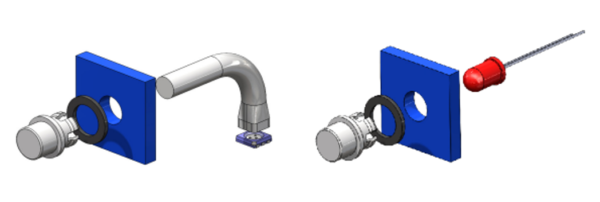
The first digit in an IP rating indicates the level of ingress protection against solid objects: from IP0x (no protection) to IP6x (complete protection against dust). The second digit refers to protection from liquids: from IPx0 (no protection) to IPx9 (protection against water jets).
Bivar SGLC is an IP68 Rated Sealing Gasket Lens Cap designed to provide ingress protection to LED status indication for applications exposed to harsh environments. The SGLC cap consists of a polycarbonate lens and IP-rated polyurethane sealing gasket and provides highly visible LED status indication with easy front mount installation. Pair sealing gasket lens caps directly with Bivar LEDs or with rigid and flexible light pipes for reinforced durability. These lens caps and black IP-rated sealing gasket fit into a 0.265 inch (6.7mm) round panel cutout and press securely into position with lens tab retention. There are low-profile dome and flat highly visible wide viewing angle Fresnel lens style options. Each lens available in clear, or tinted blue, green, red, yellow. Applications for SGLC sealing gasket lens caps include:
- Healthcare/medical
- Renewable energy
- Automotive/transformation
- Industrial automation
- Communications
Light pipe related components
A light pipe design includes more than the LED, pipe, and lens. Additional components are needed to make up a complete system, and there are several options for each one.
Mounting type
There are various mounting options for light pipes depending on your application and manufacturing requirements.
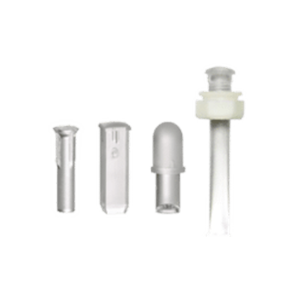
Panel Press-Fit Rigid Light Pipes
Panel Press-Fit Rigid Light Pipes mount through the front panel leaving the lens exposed on the outside. A press fit light pipe does not connect to the PCB. The light pipe hovers directly over a surface mount (SMD) LED, which channels light to the lens on the panel.
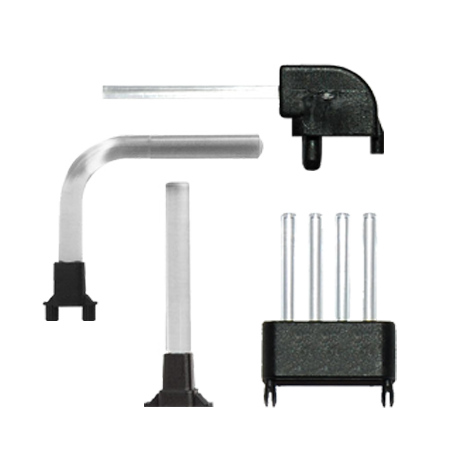
Board Mount Rigid Light Pipes
Board Mount Rigid Light Pipes have pegs on the bottom that fit snuggly into holes on the PCB. The light pipe base fits over a separate SMD LED that is also attached to the board.
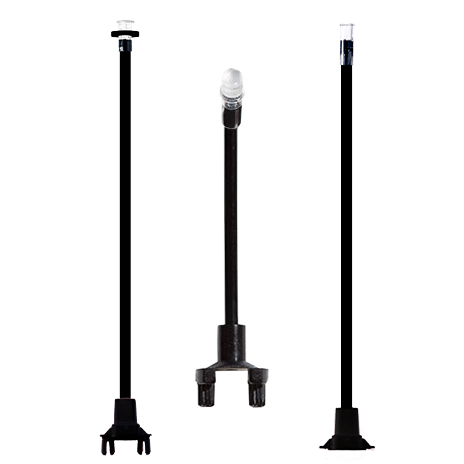
Surface Mount Flexible Light Pipes
Surface Mount Flexible Light Pipes are mounted directly to the PCB and have a SMD LED built into the adapter. The optical fiber and lens can be either front mounted from the outside of the panel or rear mounted from the back.
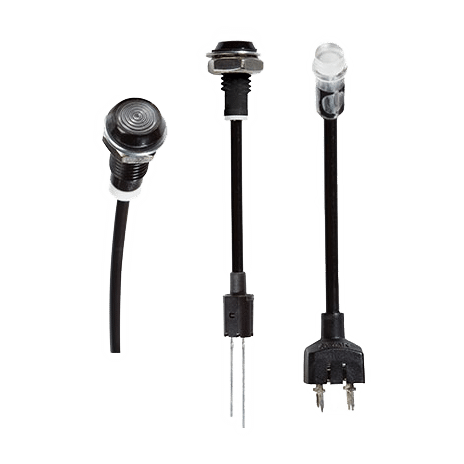
Through-Hole Flexible Light Pipes
Through-Hole Flexible Light Pipes have leads on the bottom that fit through-holes on the PCB. The optical fiber and lens can be either front mounted from the outside of the panel or rear mounted from the back.
Adapters
It is important to pair the LED with an appropriate adapter to minimize light bleed. Bivar offers adapters that are designed to fit over existing LEDs, plus integrated solutions with a built-in SMD or through-hole LED. Figure 7 shows the SMFLP adapter designed for an existing SMD LED that must be paired with a flexible light pipe.
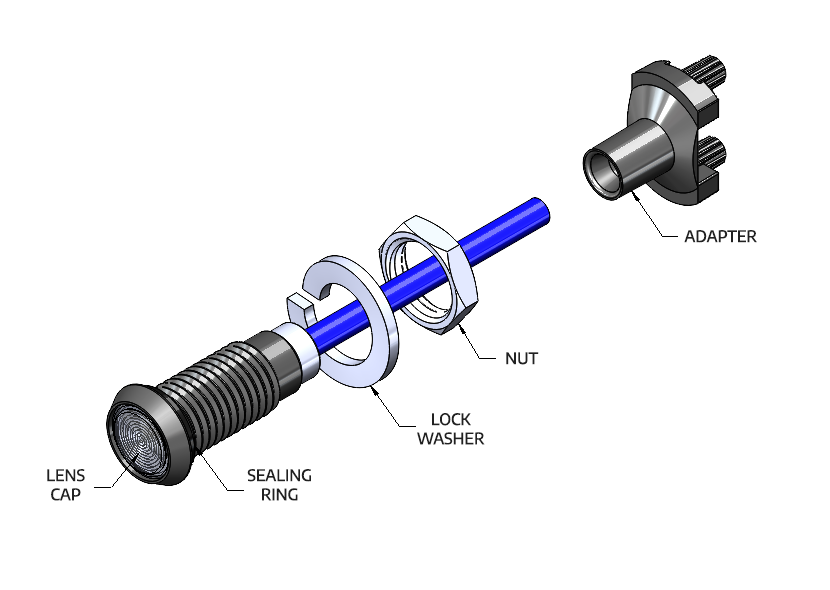
Light pipes with integrated LEDs
Integrated options are also available. The ORFLP system (Figure 8), for example, is a board-mounted adapter system with a built-in Bivar 4-pin Through-Hole Superflux LED and flexible light pipe for vertical applications.

The FLPR2-XX adapter (Figure 9) offers a built-in through-hole LED with a right-angle mounting.

The designer can choose from hundreds of combinations of LED color and light pipe length.
ZeroLightBleed™ technology eliminates light bleed
In addition to the adapters discussed above, Bivar’s innovative ZeroLightBleed™ (ZLB) technology eliminates light bleed in both rigid and flexible light pipes. The ZLB adapter channels light directly to the lens.

Figure 10 shows the component parts. The adapter assembly is soldered directly to the PCB, thus strengthening the attachment to the PCB. The new light pipe system is optimal for high vibration applications. The new system makes sourcing simple by including the ZeroLightBleed™ adapter, LED, and light pipe in one, delivering convenience and resource savings for both procurement and assembly. The adapter offers built-in single, bi-color, and tri-color LEDs in a choice of fourteen colors.
ZeroLightBleed™ solutions for flexible light pipes
The SZ family combines the ZLB adapter with a Bivar SMD LED and a flexible light pipe. Three mounting options are available: Surface Mount, Firm Retention and Post Retention. The optical fiber offers a choice of 1mm or 2mm, a choice of six colors, and lengths from 1 in to 100 ft.
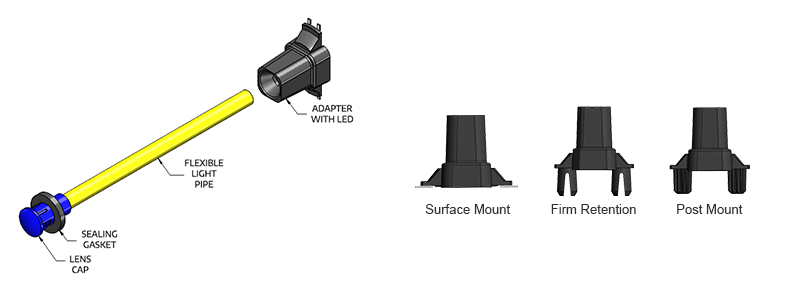
ZeroLightBleed™ solutions for rigid light pipes
Bivar offers a ZLB solution for rigid light pipes in the LPR and LPV product families. These products are available in right angle (LPR) and vertical (LPV) configurations. The all-in-one adapter system is built with optimum light pipe and LED compatibility, making light pipe design easy and delivering convenience and resource savings for procurement and assembly. Figure 12 shows an LPR example.

The LPR and LPV combine the most compatible LED and rigid light pipe pairings and provide maximum light transmission while eliminating light cross talk between light pipes.
Conclusion
Although passing light along a light pipe may seem simple enough, a successful design requires paying attention to numerous details to arrive at an optimum solution. This pillar page has discussed light pipe applications, the underlying physics, the materials used for rigid and flexible light pipes, the other system components required, and shown examples of custom solutions. Bivar offers many options for each element to give the designer maximum flexibility.




